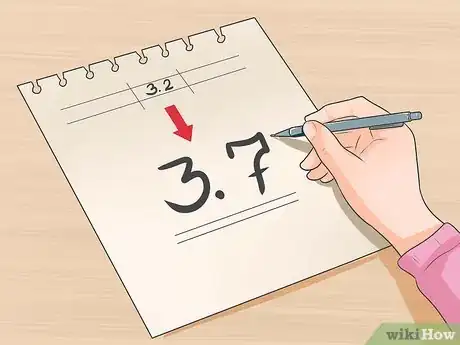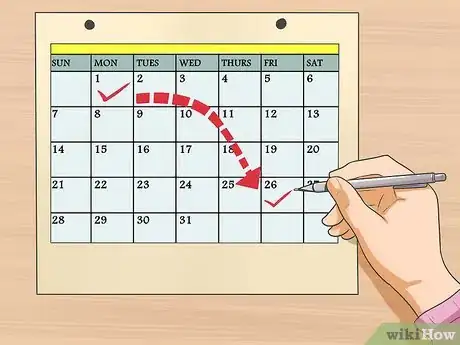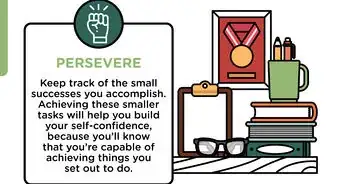This article was co-authored by Annie Lin, MBA. Annie Lin is the founder of New York Life Coaching, a life and career coaching service based in Manhattan. Her holistic approach, combining elements from both Eastern and Western wisdom traditions, has made her a highly sought-after personal coach. Annie’s work has been featured in Elle Magazine, NBC News, New York Magazine, and BBC World News. She holds an MBA degree from Oxford Brookes University. Annie is also the founder of the New York Life Coaching Institute which offers a comprehensive life coach certification program. Learn more: https://newyorklifecoaching.com
This article has been viewed 30,853 times.
One of the primary reasons people fail to achieve their goals is because they felt overwhelmed and quit. This is often because the original goal was too big. You can avoid this, however, by breaking your goal into smaller, more manageable parts. That way, your goal that seemed so big and daunting becomes something that can be accomplished over time in several steps. Upon completing these steps, you'll realize that you've reached the goal that you originally found overwhelming or even impossible.
Steps
Defining Your Goal
-
1Start with broad ideas. When formulating a goal, you may only have a vague idea what you want. This is okay. Starting broad will actually help you map out a clear path towards more specific, attainable goals.[1]
- For example, you may broadly tell yourself, "I want to be happy." This is a very large and vague goal, but it can be specified in time. Right now, what's important is that you've identified a big idea that will help guide you through the process of finding your goal.
-
2Focus in on specific aspects of your broad idea. Initially, your goal will be vague and unfocused. This is fine to start, but if your goal stays vague it will be difficult to complete. You won't be able to track your progress and determine if you've been successful. It is more effective to whittle the idea down into a more concrete and specific goal. Once you come to a precise goal, you can work on breaking it up into manageable tasks.[2]
- For example, if your original idea was to get into a good college, you have a good start but a vague goal. Narrow this idea down. What will you have to do to get into a good college? After some thought you realize that you have a lot of extracurricular activities to report, but your GPA is a little low. So with this information, you set your goal to improve your GPA.[3]
Advertisement -
3Write out a concrete goal. After narrowing down your broad idea and defining what you mean by it, you can decide what exactly your goal is. Taking your broad idea and the narrowed-down elements, you should explicitly write what exactly your goal is.[4]
- Let's stick with the goal of improving your GPA. After deciding that you need better grades, you still need to state your goal specifically. You might come up with something like "My goal is to raise my GPA from 3.2 to 3.7 by the end of the year." This will lay out exactly what you have to do and your time frame for doing so.
- Whatever your specific goal is, be sure to state it clearly. This will ensure that you have a concrete target to aim for. With a clear definition, you'll be able to lay out exactly what is required to achieve your goal. You'll also be able to assess your success more easily with a clear definition.
Dividing Your Goal
-
1Identify the different components of your goal. Even when you've made your goal as specific as possible, there will still probably be different parts to achieving it. Examine your goal and identify as many different components as you can. Then you can design a plan to accomplish each of those smaller tasks. When you do that, your overall goal will fall into place.
- Let's stick with your goal of improving your GPA. What will that entail? You decide that in order to work on your grades, you'll set aside an extra hour to study every day, go to extra help classes once a week, and meet with a tutor in your worst subject. You now have three components for your larger goal of improving your GPA, and can work out a plan to tackle each one.
-
2Develop a strategy to tackle each smaller task. Once you successfully identify the different components of your goal, you'll have to come up with a plan to accomplish each. These little chunks of your overall goal will allow you to focus on one area at a time and gradually accomplish the larger goal.
- Let's stick with the GPA goal from Step 1. Remember that you broke this goal down into 3 components: finding an extra hour per day to study, going to extra help classes, and meeting with a tutor. Each of these tasks are goals in themselves that require a plan of action.
- To find more study time, you commit to cutting back your hours watching TV and playing video games.
- For extra help classes, you decide that one day a week you'll miss track practice to attend a class after school.
- To find a tutor, you go to the office, get a list of tutors from the secretary, and contact him.
- You now have a plan in place to accomplish each sub-task of your goal.
-
3Prioritize your sub-goals. Since the point of breaking your goal into more manageable tasks is meant to prevent you from getting overwhelmed, you should avoid focusing on too many sub-goals at once. This can be just as overwhelming. Instead, analyze your list of smaller tasks and see which ones are most important to achieving your goal. Then focus on them first before moving on to other tasks that may not be so important.[5]
- While trying to improve your GPA would probably entail studying hard in all your classes, there may be a trouble area that you need to work on first. Say your grades are an 85 in math, an 89 in history, and a 70 in biology. While your grades in math and history could definitely be better, your biology grade is what's really pulling down your average. Your first focus should be improving your biology grade so it's on par with your other grades. Then, when you have a handle on biology, you can work on the rest of your subjects and raise your overall GPA.
-
4Concentrate on the tasks rather than the overall goal. Remember, the point of breaking up your goal to make it more manageable. Therefore, you should spend your time focusing on the smaller tasks you've come up with. If you start to dwell on the overall goal, you could end up overwhelming yourself.[6]
- Keep your mind focused on the smaller tasks in front of you. Remember that when you complete these tasks, your goal will be accomplished.
-
5Set benchmarks for your goal. In addition to breaking your goal into smaller tasks, another way to divide your goal is to set up a long timetable to track your progress.
- Weight loss is a good example for this. You may have an overall goal of losing 50 pounds. That large number seems daunting, and can be overwhelming. However, committing to losing 2 pounds per week sounds much more manageable. You haven't changed your goal, but you've broken up the timescale into more realistic chunks. This will help you stay committed and on track to complete your overall goal.
Achieving Your Goal
-
1Set up a timetable for your goal. It helps to set a date that you would like to achieve your goal by. This will help you stay focused and committed to working on your goal. Set timetables for the overall goal, and for each smaller task you break that goal into. That way you'll always know where you stand and if you need to adjust anything.[7]
- Say your goal is to write a book. You decide that two years from now, you'd like the book complete. This is your timetable for the overall goal.
- Break up the tasks further. Decide that you'd like the research done by the 6 month mark, the proposal written by 9 months, the contract drawn up by a year, and the final year will be committed to writing.
- Sticking to this timetable for your smaller tasks will help you reach the deadline for your overall goal.
-
2Review your progress regularly. Achieving goals is usually a process rather than a one-time commitment. While you work towards your goal, you'll need to stay motivated. A great motivator is seeing improvement. Check in with your progress regularly to ensure you see results as they happen. It helps to keep a written log of your progress and update it every week or month. Careful monitoring will also let you know if you've fallen behind your goal. If you stop seeing improvement, you know you have to work harder.[8]
- Let's continue with the goal of improving your grades this year at school. You should keep a log of your grades as the year goes on. If you see an upward trend, then you know that you're studying right and your goal is becoming a reality. If you see a downward trend, you know you'll need to improve if you want to accomplish your goal.
-
3Tell people about your goal and ask for help if you need it. Sometimes it can be difficult to keep yourself motivated all the time. If your goal is difficult or you aren't seeing progress fast enough, it's normal to get frustrated. This is where a support network comes in. By telling friends and family about your goal, you're creating a network that can help you if things get tough. With a good support group, a difficult goal becomes much more attainable.[9]
- Couples trying to lose weight is a good example. If you and your partner are trying to lose weight together, you can keep each other accountable for dieting and working out. Your partner can talk you out of eating junk foods and motivate you to exercise. This way, you can stay more committed to a goal than if you were trying to do it all alone.
-
4Identify obstacles you might encounter. When working towards any goal, it is almost inevitable that you'll experience hardships. The key is not avoiding obstacles, but planning for them. If you anticipate problems ahead of time, you can have a system in place for overcoming them.
- Say your goal is to cut down on your alcohol intake. You know that your friends will probably pressure you to drink when you're around them, which represents an obstacle to your goal. To plan for this, start by letting your friends know that your goal is to drink less and ask them not to offer you drinks. Make a commitment to yourself that if they don't stop pressuring you, you'll remove yourself from the situation.
-
5Celebrate your successes. Each time you complete one of your sub-goals, it is a cause for celebration. You're one step closer to achieving your overall goal, and you should be proud of that. Celebrate any way you want: watch a movie, go out for dinner, take a day off. It doesn't matter. These little celebrations will give you something to look forward to and keep you motivated to accomplish your goal.
Goal Setting Template
References
- ↑ Annie Lin, MBA. Life & Career Coach. Expert Interview. 25 November 2019.
- ↑ Annie Lin, MBA. Life & Career Coach. Expert Interview. 25 November 2019.
- ↑ https://home.ubalt.edu/tmitch/642/Articles%20syllabus/Locke%20et%20al%20New%20dir%20goal%20setting%2006.pdf
- ↑ https://home.ubalt.edu/tmitch/642/Articles%20syllabus/Locke%20et%20al%20New%20dir%20goal%20setting%2006.pdf
- ↑ Annie Lin, MBA. Life & Career Coach. Expert Interview. 25 November 2019.
- ↑ https://www.apa.org/topics/behavioral-health/new-year-resolutions
- ↑ Annie Lin, MBA. Life & Career Coach. Expert Interview. 25 November 2019.
- ↑ https://www.fredonia.edu/student-life/career-development-office/successful-career-planning
- ↑ https://www.apa.org/topics/behavioral-health/new-year-resolutions









































































